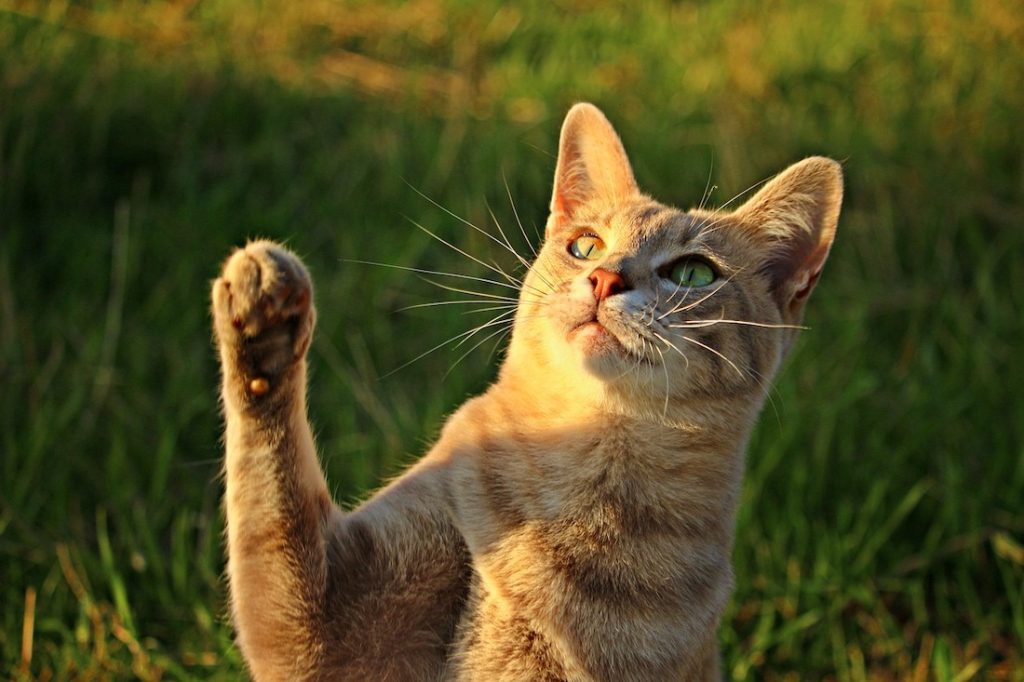
As anyone who’s watched a kitten play knows, cats are graceful and agile animals. They’re also intelligent, curious creatures that manipulate objects with their paws. But do cats have a dominant foot, like some humans are right- or left-handed? This article will explore whether cats are left- or right-handed and what factors determine paw preference.
Do Cats have a Paw Preference?
Some researchers believe cats have a paw preference. Paw preference is referred to as lateralization. For example, a study at The Animal Behavior Center at Queen’s University Belfast collected data from the owners of forty-four mixed breed cats, twenty females, and twenty-four males was used to see whether their feline friends used their right or left paws when doing specific tasks. These tasks were taking the first step down the stairs, stepping into the cat box, and determining which side they liked to lay on the most. These three behaviors were recorded until each behavior was performed fifty times.
Another experiment was done by placing treats into three-tiered containers and observing which paw the cats used to get the treat out. In addition, this study showed that cats exhibit evidence of paw preference like humans.
This study found that cats don’t prefer a particular paw like humans do, with the majority being right-handed, but certain individual cats display handedness. Seventy-three percent show a preference when reaching for food, seventy percent when taking the first step downstairs, and sixty-six favor a particular paw when stepping into their litter box. Only twenty-five percent of the cats in the study preferred a specific side to lay on.
Is a Cats Handedness Based On Their Gender?
A cats handedness seems linked to their gender. For example, the females were more likely to favor their right paw, while males favored their left. Studies of dogs have suggested that hormonal factors might influence lateral biases, but all the cats involved in the recent research were spayed and neutered. In my experience as a cat owner, I’ve found that one of my cats, a spayed female, uses her right paw to scoop hard food from her dish. She does this every time.
Deborah Wells, the study co-author, tells Barbara J. King of NPR, “Further work is needed to investigate this, but the strong sex effects reported here, and elsewhere, both on experimental challenges and expressions of spontaneous behavior, and using both castrated and de-sexed populations, point more and more strongly to underlying differences in the neural architecture of male and female animals.”
Wells explains that left-limbed animals use the right hemisphere of their brains more and tend to have stronger fear responses and aggressive reactions than their right-pawed peers. Conversely, the right-pawed dominant animals use the left hemisphere of their brains more. Ambidextrous animals also tend to show susceptibility to stress more than right-pawed animals. This helps understand which side of the brain an animal uses and why they are vulnerable to anxiety, fear, and aggression.
This study also found that cats do not show a paw preference for walking and other everyday tasks. Instead, they use a preferred paw to do more complex tasks like reaching for a toy or food. A study in the International Journal of Neuroscience also found that female cats usually favor their right paw, while male cats use their left paw for these tasks.
Why Do Cats Have a Paw Preference?

Paw preference may have to do with the way the brain processes information. Just like humans, cats may prefer using one paw over the other because of how the neural networks in their brains are structured.
A cat’s paw preference may also have to do with their genetics. Many species exhibit handedness, including primates, dogs, and even snails. Polymorphism, a genetic variability influencing paw preference, can be found in humans and animals. Another theory is that exposure to certain hormones in the womb can affect the development of neural connections and contribute to handedness.
It’s important to note that not all cats exhibit a paw preference. Some cats may use both paws equally, while others may switch between paws for different tasks. It’s also important to remember that paw preference may develop or change over time, especially if a cat experiences a health issue or an injury in one of its paws.
Conclusion
We found that cats do have paw preferences. Some cats are left-pawed, others are right-pawed, and still, some show an ambidextrous approach. Various factors may influence a cat’s paw preference, including brain structure, genetics, and exposure to certain hormones, just like in humans. However, whether or not a cat has a paw preference, one thing is certain, these agile, curious creatures will continue to fascinate and amaze their owners for years with their skillful paw manipulation and playful antics.